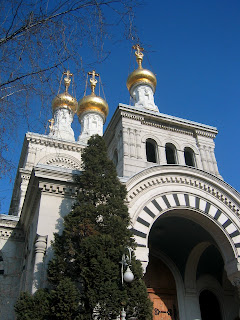Even though Geneva is a small city, it was able (and willing -- chilly, but blue skies and sun all around) to reveal new sights. I took the time to walk around the Old Town area, probably the most visited section of the city (right after the
jet d'eau). I've been reading Karen Armstrong's
A History of God, so I had worship and idolatry and creation stories on the brain. Among the many churches I saw was a Russian church, complete with the traditional gold domes. What surprised me about the design was the arc of alternating black and white stripes at the entrance (pictured left). It reminded me of the Mezquita, the mosque in Cordoba (pictured right). A coincidence of design, or is there a deeper meaning here?
The history of
the Mezquita is fascinating. First a Roman temple, converted into a Christian church (destroying some of the Roman temple but retaining the columns), then a Muslim mosque (adding the great arches), then a Christian site once again (constructing a small cathedral in the center of the mosque). (Need I mention how odd it was to see a miniature cathedral in the middle of a mosque?)
Passed from religion to religion, with each new owner making changes but retaining crucial architectural elements, it is a curious study in artistic appreciation weighed against religious focus and superiority. In A History of God, I've been reading about the development of early Judaism, and the emergence of an unusual concept for the time: the idea of a "one and only" God, and no others. The author explains that early Judaism had been accepting of other gods, or, at the least, tolerant. But by the time of Josiah (~620 BCE), Yahweh was a God who would not tolerate idols of or temples for other gods, nor people who worshipped other gods. There was much bloodshed in the name of God, a foreshadowing of the holy wars to come.
Which brings me to the second round of Christians who took over the Mezquita. If the Christians were so determined to refocus the Mezquita by
building a cathedral inside of it, why not just start from scratch, destroy the building, and create a temple anew? Perhaps they, too, could see the beauty of the striped arches, the spirituality of the space. Or maybe they decided to keep the building simply as a shell to house their temple, understanding the value (in terms of materials and labor) of the existing structure. Whatever the reason, I'm the happier for their choice.



